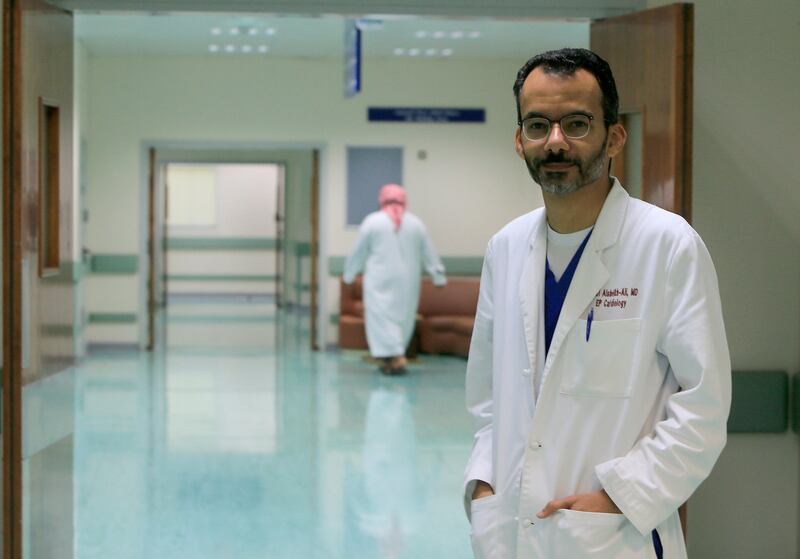A ground-breaking study in the UAE has found that greater wealth has a significant downside for many people by making them more at risk of coronary artery disease.
The findings contrast with many developed parts of the world, where poorer people are more likely to develop the potentially fatal condition.
Patients in a test group earning more than $5,300 per month were "significantly" more likely to have coronary artery disease (CAD) and the related multi-vessel disease than those earning less than $1,300.
They do, however, tie in with what is often happening in developing countries, where increasing wealth creates a lifestyle that lead to greater rates of CAD.
One of the study’s authors, Dr Alawi Alsheikh-Ali, dean of the College of Medicine and professor of cardiovascular medicine at the Mohammed Bin Rashid University of Medicine and Health Sciences (MBRU) in Dubai, said higher rates of diabetes, obesity and a sedentary lifestyle among wealthier people accounted for the study’s findings.
“The collective take-home message from this growing literature is that socioeconomic development is typically accompanied by increased risk of chronic diseases such as heart disease, which is likely driven by lifestyle risk factors,” he added.
Published in The Open Cardiovascular Medicine Journal, the research looked at more than 1,000 patients undergoing a coronary angiography, a procedure in which dye is injected into the heart’s blood vessels to look for narrowing, at five hospitals in the UAE and Saudi Arabia.
_______________
Read more:
[ Patients as young as 28 having heart attacks ]
[ Heart disease responsible for one in three deaths in Dubai ]
[ 'Outrageous' levels of sodium spark warnings over pizza and burgers ]
_______________
When the data on the 1,068 patients were analysed for CAD, a condition characterised by a narrowing of a major blood vessel in the heart, it was found that people who were unemployed were at greater risk than those in work. Also, it was found that people with greater incomes had higher rates of CAD and a related condition called multi-vessel disease than people who earned less.
“Anticipation and recognition of such a disease burden can help guide public health and education campaigns to combat chronic disease,” said Dr Alsheikh-Ali.
Among the other researchers involved was Dr Salem Al Kaabi of the cardiology department at Zayed Military Hospital, Abu Dhabi.
Another of the study’s authors, Dr Amin Daoulah, of King Faisal Specialist Hospital and Research Centre in Jeddah, Saudi Arabia, said that that the “well-accepted socioeconomic CAD gradient”, in which poor people were most susceptible, and risks fell as income increased, a pattern often found in developed countries, “might not be applicable to all regions of the world”.
“We suggest that the interpretation of socioeconomic status should take into account the differences in risk factors among different ethnicities and cultural differences in individual lifestyles from the same socioeconomic status,” he said.
“Broader studies are needed to explore this association, which is in contradiction to what has been previously reported of the link between coronary vascular disease and lower socioeconomic standing.”
Another finding was that people in rural areas were more at risk of heart problems than those in urban areas, something the researchers suggested may be because they have less access to medical care such as screening services.
_______________
Read more:
[ Reducing salt and transfat intake crucial to tackling health problems ]
[ Leafy greens, avocados and almonds: how to lower your blood pressure naturally ]
_______________
Professor Julia Critchley, a scientist not associated with the study, but who has researched efforts to combat heart disease and diabetes in the Arab world, suggested the low levels of education among many patients in the study may explain the finding that wealthier individuals were at higher risk of CAD.
When people have a low level of education, greater wealth may lead them to adopt unhealthier lifestyles, an outcome not typically seen among better-educated groups.
“Income may be protective against obesity, only when someone is highly educated,” said Prof Critchley, a professor of epidemiology at St George’s, University of London.
For example, a 2012 study of women in Egypt found that, among the less well educated, greater wealth was associated with a higher risk of obesity, a trend not seen among more highly educated women.
“With education, people use their income to make positive choices. That’s not necessarily the case for people who are illiterate; they may not be making health-improving choices,” said Prof Critchley, who said that, among people who were less well educated, rising wealth could lead people to smoke more and eat less healthy foods.
“Large-scale studies investigating socio-economic effects in detail have generally only been carried out in high-income countries,” she added.
“Larger studies with multiple different measures of socio-economic status which can be assessed both individually and in combination would be very useful to better understand the way they interact and help design culturally specific responses.”
The recent study, titled 'Socioeconomic factors and severity of coronary artery disease in patients undergoing coronary angiography: A multicentre study of Arabian Gulf states', was written by 16 researchers in the UAE, Saudi Arabia and the United States.
Many developed nations have seen their death rates from cardiovascular disease fall over the past several decades and there are initiatives in the Gulf aimed at achieving a similar result.
Dr Alsheikh-Ali highlighted the recently launched Gulf Population Risks and Epidemiology of Vascular Events and Treatment study (Gulf PREVENT), which aims to quantify how much conventional risk factors are causing heart attacks in young adults and also hopes to identify new risks.
“The study aims to identify barriers to adherence to treatment after discharge with a heart attack, including socioeconomic barriers,” he said.







